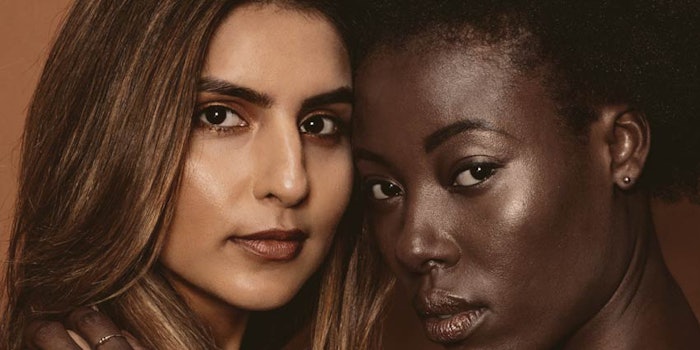
By the year 2050, over half of the United States population will be people of color as indicated by the U.S. Census.1 People of color in the United States have a buying power reaching $1.2 trillion.2 As the population increases, there is a growing demand for esthetic services and therapies specifically designed for skin of color. This presents a big opportunity considering women of color spend over $7.5 billion on beauty products.3 To demystify skin of color, there must be an in-depth understanding of the unique structure and function of skin of color. Also, how these differences impact the presence of certain skin diseases in people of color and cultural practices will play a role in the treatment of these conditions.
Defining Skin of Color
Skin of color is defined as pigmented skin that is non-Caucasian and falls within Fitzpatrick skin types III-VI. Those with skin of color include Africans, African-Americans, Afro-Caribbeans, Hispanics, Asians, Pacific Islanders, Native Americans and Middle Easterners. The term ethnic skin is sometimes used in place of skin of color in the dermatology and cosmetic industries.
The Unique Structure and Function
The stratum corneum layer of the skin is a barrier to protect the body from the environment, microorganisms, punctures, ultraviolet light and irritants. The stratum corneum also prevents water loss in the skin. Transepidermal water loss (TEWL) is the total amount of water lost in the skin.

The epidermis is composed of keratinocytes and is divided into: the basal layer, the stratum spinosum and the stratum granulosum. Melanocytes reside in the basal layer and produce melanin from melanosomes, which create pigment in the skin through the process of melanogenesis. The protein tyrosine goes through a series of reactions within the cell and converts into melanin. Everyone has the same quantity of melanocytes.
The dermis supports the epidermis. It has two layers: the superficial papillary dermis and the deeper reticular dermis. The reticular dermis houses fibroblasts, blood vessels, collagen, elastic fibers, sebaceous glands, apocrine glands and eccrine glands.
Skin of color is distinct in its structure and function. The differences in structure and function are discussed below.
Melanosomes. There are more melanosomes in darker skin tones.
pH.There have been differences in pH found in the stratum corneum of skin of color. Black women were found to have a lower pH than Caucasian women. Skin pH is responsible for maintaining homeostasis.
Melanogenesis. The rate of melanogenesis increases in darker skin tones when there is ultraviolet light exposure. What follows is an increase in the expression of the p53 gene, which is involved in DNA repair mechanism. For darker skin tones, the UV repair mechanism is therefore stronger. Melanin serves as a photoprotector for the skin.
TEWL. Studies have suggested that black and Asian skin has greater TEWL than Caucasian skin. This open barrier could lead to more irritant-prone skin.
Fibroblasts. Darker skin tones have much larger nucleated fibroblasts and smaller collagen fiber bundles. This contributes to people of color aging gracefully and exhibiting minimal lines and wrinkles. However, it can also lead to keloids.
Common Disorders
Some of the common disorders found in skin of color are post-inflammatory hyperpigmentation, pseudofolliculitis barbae, melasma, vitiligo and acne keloidalis nuchae
Post-inflammatory Hyperpigmentation
Post-Inflammatory hyperpigmentation (PIH) is a pigmentary disorder in which the skin darkens after an inflammatory response or injury occurs in the skin cells. Acne vulgaris, atopic dermatitis, psoriasis, allergic reaction to insect bites, cosmetic procedures, medications and wounds are examples of inflammatory responses that cause PIH. PIH is common among ethnic groups and presents as dark patches in the cutaneous tissue where the inflammatory injury occurred. An excessive amount of melanin is created at the point of inflammation thereby causing PIH. The presentation of PIH varies among different ethnicities. PIH can be challenging to treat especially if it is in the deep layers of the skin. In some cases, it may take several years to treat PIH while it may be untreatable in other cases.
Pseudofolliculitis Barbae
Pseudofolliculitis barbae is an inflammatory disorder of the epidermis and dermis that appears as papules and pustules in the skin. This condition is primarily seen in the beard area of men of color. It occurs when curved hairs regrow into the follicles after shaving.
Melasma
Melasma or chloasma is another pigmentary disorder commonly seen in women of color. It is especially seen more in Hispanic and Asian women. Melasma appears as tan or brown splotches on the face. The cause of melasma is unknown. Melasma is triggered by pregnancy, sun exposure, genetics, hormonal changes in estrogen and progesterone, oral contraceptives, nutritional supplements and anti-seizure medication.
Vitiligo
Vitiligo is a pigmentary autoimmune disorder where there is a loss of pigment in the skin due to the lack of epidermal melanocytes. It can occur at any age. In the early stages, it usually occurs as a small patch on a limb or face and then it spreads over time. Approximately .01% to 3% of the world population suffers from vitiligo. This disorder deeply affects the client’s self-image. The cause of the disorder is unknown.
Acne Keloidalis Nuchae
Acne keloidalis nuchae is an inflammatory disease where keloid-like papules and pustules form on the occipital scalp and posterior neck. As acne keloidalis nuchae progresses, the papules turn into plaque-like keloids. This condition is common in men of African descent with coarse and curly hair. The cause is unknown.
Psychosocial and Cultural Influences
Many ethnic groups have experienced shadeism or colorism, which is a form of prejudice or discrimination based on their skin color. Due to colorism, those of lighter skin tones are accepted over those of darker skin tones. Self-esteem and self-acceptance becomes a struggle for some of these individuals because some societies places more value on the European standard of beauty.
For example, Indians have a caste system based not only on class but also on color. Indians with dark-toned skin are not viewed as beautiful as those with light toned skin. Therefore, lighter skinned Indians are favored to receive better opportunities in marriage partners, employment and social organizations. Because of this, there has been a surge in sales of harsh skin lightening creams of colorism in India. With the hopes of achieving a better life, many have permanently damaged their skin using these lightening creams.
In the African-American community, the “brown-paper bag test” was once used to determine acceptance in certain social circles. Having a lighter skin tone in comparison to the color of the paper bag was required to marry into certain families. If one’s color was darker than the bag, then the individual was not awarded the certain privileges such as membership into an organization. Although practices such as the “brown-paper bag test” are no longer performed today, the beliefs are still deeply embedded in the culture.
The esthetician will need to be aware of the psychosocial influences on the client’s view of themselves, how the world views them and the impact it has on the treatment of skin disorders. Grooming practices such as the use of henna in decorative cosmetics by Africans and Indians should be noted. Hispanics consume chili peppers in their diet, which could lead to capsaicin dermatitis with irritation and burning pain. It is important for estheticians to be culturally sensitive to these types of issues and include a cultural assessment in the service intake to better care for and enhance the client’s quality of life.
Seize the Opportunity
The demand for treating common disorders in skin of color is growing, and it presents an opportunity for estheticians. Women and men of color are looking for skin care specialists that understand their skin care needs and produce positive results in their skin health. Esthetic education will need to teach students how to specifically address the skin disorders commonly found in skin of color to adequately treat this demographic. The esthetician who remains educated on the science of skin of color and pairs it with an understanding of cultural influences will not only enhance their clients’ quality of life but will demystify skin of color for the profitability of their practice.












